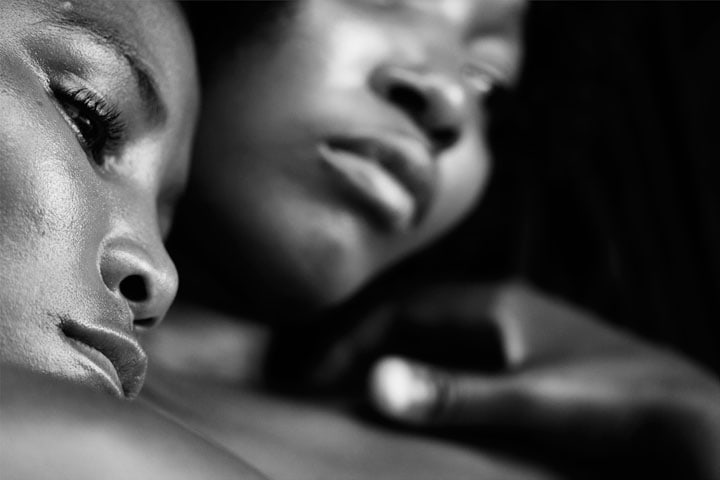Photographs from Zanele Muholi, a South African black lesbian who documents the daily lives – and deaths – of black homosexuals, often at her own risk.
(Click on the image above to open the gallery and view some of Muholi’s work.)
While Russia and Ukraine plan to ban homosexual “propaganda”, and Uganda tries to rush through an anti-homosexuality bill that would send gays, lesbians and those who promote homosexuality to jail, South African visual activist Zanele Muholi has kindly offered IFEX a selection of her photographs that documents the daily lives – and deaths – of black homosexuals.
“South Africa has its own political agenda,” she says. “We have laws in place that protect our community but people are still getting killed.” South African homosexuals have made obvious gains in the political sphere. Same-sex marriage is legal. It’s the first country worldwide to draft a constitution that explicitly forbids discrimination based on sexuality.
Yet hate crimes against gays and lesbians are pervasive. “We have a schizophrenic constitution in place, which clashes with traditional attitudes,” says Muholi. “How many people have had the opportunity to fully understand what the constitution actually means?”
She points to South Africa’s “harsh reality” for women and the LGBTI community: at least 10 people, mostly lesbians, have been killed in hate crimes this year alone. None of the murders have resulted in a conviction. Many other individuals face harassment and rape. According to The New Yorker, one in every two women in the country can expect to be raped at least once in her lifetime.
Most recently, lesbian activist Sihle Sikoji was killed by a gang of men in Cape Town on 10 November on a night out, less than a week after she turned 19. Sikoji, a member of the Luleki Sizwe project that supports lesbian, bisexual and transgender women who have been raped, was stabbed to death.
“They [the attackers] didn’t ask for money or cellphones. Most men hate us around here; they say we are trying to take their girlfriends,” said a friend (name withheld) who was with her at the time of the stabbing.
Such attacks have been the driving force behind Muholi’s work. Some of her subjects are survivors of “curative” rape – when a man rapes a lesbian to “cure” her sexual orientation. Most recently, Muholi has started recording the funerals of black lesbians killed in hate crimes – including Sikoji’s.
“We can’t just wait for the Pride parade, or other fun activities,” she explains. “Funerals are part of our lives. We are losing people and that needs to be documented.”
Muholi herself has encountered censorship for chronicling the lives of homosexuals. In August 2009, the then Minister of Arts and Culture, Lulu Xingwana, walked out of an exhibition featuring Muholi’s work, calling it “immoral”, “offensive” and “going against nation-building.”
In April 2012, her flat was broken into and more than 20 of her hard drives containing videos and photos were stolen, most of which had never been exhibited, effectively erasing the past five years of her work. Nothing else was taken.
When asked why she perseveres at such obvious risk to herself, Zanele says simply, “I’m an insider in the black lesbian community. We have a responsibility as a community to speak up for ourselves so that others have an understanding of our existence.”
Click the image above to open a gallery of some of Muholi’s work that records the “lifelines and timeline of some of that stolen ‘queer’ history.”
<img src=”/south_africa/2012/12/19/muholi_mfo.jpg” alt=”From the Faces and Phases series”>
From the Faces and Phases seriesZanele Muholi
<img src=”/south_africa/2012/12/19/muholi_sebetoane.jpg” alt=”From the Faces and Phases series”>
From the Faces and Phases seriesZanele Muholi
<img src=”/south_africa/2012/12/19/muholi_mpako_ayanda.jpg” alt=”From the Being series, courtesy of Stevenson, Cape Town and Johannesburg”>
From the Being series, courtesy of Stevenson, Cape Town and JohannesburgZanele Muholi
<img src=”/south_africa/2012/12/19/muholi_liter_1.jpg” alt=”From the MO(U)RNING exhibition, courtesy of Stevenson, Cape Town and Johannesburg”>
From the MO(U)RNING exhibition, courtesy of Stevenson, Cape Town and JohannesburgZanele Muholi
<img src=”/south_africa/2012/12/19/muholi_liter_3.jpg” alt=”From the MO(U)RNING exhibition, courtesy of Stevenson, Cape Town and Johannesburg”>
From the MO(U)RNING exhibition, courtesy of Stevenson, Cape Town and JohannesburgZanele Muholi
<img src=”/south_africa/2012/12/19/muholi_beaded_poster_2.jpg” alt=”From the MO(U)RNING exhibition, courtesy of Stevenson, Cape Town and Johannesburg”>
From the MO(U)RNING exhibition, courtesy of Stevenson, Cape Town and JohannesburgZanele Muholi
<img src=”/south_africa/2012/12/19/muholi_difficult_love_1.png” alt=”From the Difficult Love documentary, 2010, courtesy of Stevenson, Cape Town and Johannesburg”>
From the Difficult Love documentary, 2010, courtesy of Stevenson, Cape Town and JohannesburgZanele Muholi
<img src=”/south_africa/2012/12/19/muholi_crime_scene_1.jpg” alt=”From the MO(U)RNING exhibition, courtesy of Stevenson, Cape Town and Johannesburg”>
From the MO(U)RNING exhibition, courtesy of Stevenson, Cape Town and JohannesburgZanele Muholi

Inkanyiso ProductionsZanele Muholi

Inkanyiso ProductionsZanele Muholi
<img src=”/south_africa/2012/12/19/muholi_24_screenshot_2.png” alt=”From the @24 video, 2011-2012, courtesy of Stevenson, Cape Town and Johannesburg”>
From the @24 video, 2011-2012, courtesy of Stevenson, Cape Town and JohannesburgZanele Muholi
<img src=”/south_africa/2012/12/19/muholi_24_screenshot_1.png” alt=”From the @24 video, 2011-2012, courtesy of Stevenson, Cape Town and Johannesburg Zanele Muholi”>
From the @24 video, 2011-2012, courtesy of Stevenson, Cape Town and Johannesburg Zanele MuholiZanele Muholi
